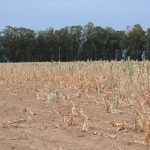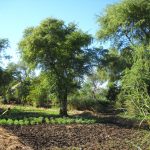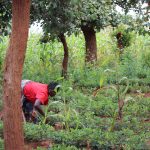Zielgruppe: NGO
The smallholder farmers in sub-Saharan Africa need you
Agroforestry systems combine planting crops and trees or shrubs at the same time. Smallholder farmers in sub-Saharan Africa are particularly threatened by severe weather conditions, climate change and food insecurity. Bulk regions have a serious potential for setting up or transferring to agroforestry systems, which could be the vital approach to overcome these challenges.

Single crop farming systems are highly affected by droughts and floods (https://www.nasa.gov/feature/goddard/2019/when-drought-threatens-crops-nasa-s-role-in-famine-warnings)
Agroforestry as a solution to many problems
Not only climate change but also population growth is an increasing challenge for sub-Saharan countries. Food and income insecurity caused by extreme weather events threaten a lot of smallholder farmers. Agroforestry addresses both of the mentioned problems.
Several studies provide data showing that the crop yield could be increased after implementing agroforestry. Agriculture becomes more resilient, because trees and shrubs promote soil fertility and efficient water usage. Additionally, agroforestry systems provide a certain shelter against pests compared to monoculture. With trees, infiltration rates increase while surface water runoff and soil evaporation decline.

Agroforestry provides a more resilient cropping system being less prone to droughts and floods (http://blog.worldagroforestry.org/index.php/2016/07/20/trees-on-farms-the-missing-link-in-carbon-accounting/)
However, increased productivity is not the only advantage regarding the farmers income: for example in Nigeria, firewood covers up to 90% of the total energy supply. Bulk regions in sub-Saharan Africa lack of wood as an energy source as well as a construction material. This increased demand for wood can lead to deforestation. Using the trees from agroforestry systems can be a carbon neutral alternative. Selling wood can be an additional source of income and can help by-pass crop failures or low yields.
Moreover, carbon payments for sequestered carbon by the planted trees, as it was introduced in a project in Mozambique, can further increase smallholder farmers income. These carbon payments can help overcome one of agroforestry major problems: the transition to agroforestry systems requires upfront investments. For the best results, farmers should be involved in the transition process from the very beginning. They have to be trained in managing natural resources. Unfortunately, the knowledge transfer doesn’t work very well yet.
Transforming to agroforestry means implementing a whole new system. This process offers the opportunity to rethink the role of women in agriculture. The empowerment and involvement of women, by giving them access to better tools for example, improves efficiency and yield in agroforestry systems and therefore increases food security.

Empowering women and increasing outcome through agroforestry (http://blog.worldagroforestry.org/index.php/2015/04/13/beating-famine-conference-tackles-food-insecurity-in-southern-africa/)
Agroforestry is a long-lasting adaption to climate change. It also provides a carbon sink which contributes to climate change mitigation. Trees store carbon in their biomass and mulch changes the soil structure. This results in soil with a higher capacity to store carbon.
Possible hardships
Just to be clear: this report only looked at transformations from monoculture and non-agroforestry agriculture to agroforestry systems. The impacts on nature and soil fertility are worse, if primary forest is converted into agroforestry systems.
However, as mentioned before, the conversion of non-agroforestry to agroforestry systems can make tremendous differences for smallholders. There are just three major challenges smallholders are facing:
- Upscaling of agroforestry practices can be hard due to land tenure issues, lack of social and financial capital and policies.
- There is no one-size-fits-all solution. Different crops and soils require different trees and shrubs.
- The trees or shrubs have to meet the needs of the crop and there should be a minimum of competition. For example, moisture should not be a limiting factor in agroforestry systems. Further research is needed to find perfectly matching plants.
Despite these problems, there are concrete examples, where agroforestry brought stunning results. The combination of maize and faidherbia albidia in Zambia lead to an enormous decrease of fertilizer demand and covered up to 100% of the potassium needs. Cocoa plantations in multi-strata systems have shown greater crop yields. The combination of maize and glircidia in Malawi even resulted in a yield threefold the amount compared to a single crop system without soil amendments.
Why and how NGOs should help
Loans for smallholders are crucial in order for them to benefit from agroforestry systems. NGOs play a crucial role in scaling up agroforestry by supporting smallholders acquiring local knowledge, develop suggestions tailored to each smallholder’s need through structured stakeholder engagement and address the local constraints. NGOs should act as a connecting link between smallholder farmers, stakeholder and government institutions to improve money and knowledge transfer. With your support to upscale agroforestry practices, lives of many smallholders in sub-Saharan Africa can be changed while simultaneously reducing hunger and mitigating climate change.
References
Nair, P. K. R., Buresh, R. J., Mugendi, D. N. & Latt, C. R. Nutrient Cycling in Tropical Agroforestry Systems: Myths and Science. CRC Press LLC 30 (1999).
Norgrove, L. & Hauser, S. Yield of plantain grown under different tree densities and ‘slash and mulch’ versus ‘slash and burn’ management in an agrisilvicultural system in southern Cameroon. F. Crop. Res. 78, 185–195 (2002).
Vaast, P. & Somarriba, E. Trade-offs between crop intensification and ecosystem services: the role of agroforestry in cocoa cultivation. Agroforestry Systems vol. 88 947–956 (2014).
Thorlakson, T. & Neufeldt, H. Reducing subsistence farmers’ vulnerability to climate change:
evaluating the potential contributions of agroforestry in western Kenya. Agric. Food Secur. 1, 15
(2012).
Lasco, R. D., Delfino, R. J. P. & Espaldon, M. L. O. Agroforestry systems: Helping smallholders
adapt to climate risks while mitigating climate change. Wiley Interdiscip. Rev. Clim. Chang. 5, 825–
833 (2014).
Adenrele Adeniyi, S., Petrus De Clercq, W. & Van Niekerk, A. Development of a composite soil degradation assessment index for cocoa agroecosystems in southwestern Nigeria. Solid Earth 8,
827–843 (2017).
Adesina, F. A. et al. Potential of agroforestry techniques in mitigating CO2 emissions in Nigeria:
some preliminary estimates. Glob. Ecol. Biogeogr. 8, 163–173 (1999).
Verchot, L. V. et al. Fluxes of CH4, CO2, NO, and N2O in an improved fallow agroforestry system in
eastern Amazonia. Agric. Ecosyst. Environ. 126, 113–121 (2008).
Kuyah, S. et al. Agroforestry delivers a win-win solution for ecosystem services in sub-Saharan
Africa. A meta-analysis. Agron. Sustain. Dev. 39, (2019).
Sanou, L., Savadogo, P., Ezebilo, E. E. & Thiombiano, A. Drivers of farmers’ decisions to adopt
agroforestry: Evidence from the Sudanian savanna zone, Burkina Faso. Renew. Agric. Food Syst.
34, 116–133 (2019).
Lasco, R. D., Delfino, R. J. P., Catacutan, D. C., Simelton, E. S. & Wilson, D. M. Climate risk
adaptation by smallholder farmers: the roles of trees and agroforestry. Curr. Opin. Environ.
Sustain. 6, 83–88 (2014).
Benjamin, E. O., Ola, O. & Buchenrieder, G. Does an agroforestry scheme with payment for
ecosystem services (PES) economically empower women in sub-Saharan Africa? Ecosyst. Serv. 31,
1–11 (2018).
Dumont, E. S., Bonhomme, S., Pagella, T. F. & Sinclair, F. L. Structured Stakeholder Engagement Leads to Development of More Diverse and Inclusive Agroforestry Options. Exp. Agric. 55, 252–274 (2019).
Kürsten, E. & Burschel, P. CO2-mitigation by agroforestry. Water, Air, Soil Pollut. 70, 533–544
(1993).
Obeng, E. A. & Aguilar, F. X. Marginal effects on biodiversity, carbon sequestration and nutrient cycling of transitions from tropical forests to cacao farming systems. Agrofor. Syst. 89, 19–35 (2015).
Russell, D. & Franzel, S. Trees of prosperity: Agroforestry, markets and the African smallholder.
Agrofor. Syst. 61, 345–355 (2004).
Partey, S. T., Zougmoré, R. B., Ouédraogo, M. & Thevathasan, N. V. Why promote improved
fallows as a climate-smart agroforestry technology in sub-Saharan Africa? Sustain. 9, 1–12 (2017).
Makumba, W. et al. The long-term effects of a gliricidia-maize intercropping system in Southern Malawi, on gliricidia and maize yields, and soil properties. Agric. Ecosyst. Environ. 116, 85–92 (2006).
Norgrove, L. & Hauser, S. Yield of plantain grown under different tree densities and ‘slash and
mulch’ versus ‘slash and burn’ management in an agrisilvicultural system in southern Cameroon.
F. Crop. Res. 78, 185–195 (2002).
Yengwe, J., Amalia, O., Lungu, O. I. & De Neve, S. Quantifying nutrient deposition and yield levels of maize (Zea mays) under Faidherbia albida agroforestry system in Zambia. Eur. J. Agron. 99, 148–155 (2018).
Garrity, D. P. et al. Evergreen Agriculture: A robust approach to sustainable food security in Africa. Food Secur. 2, 197–214 (2010).
Feedback/Errata
9 Responses to Blog 14 – The smallholder farmers in sub-Saharan Africa need you